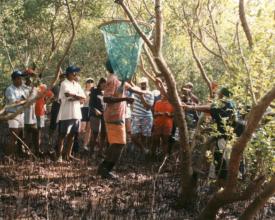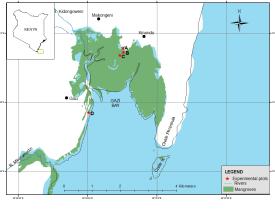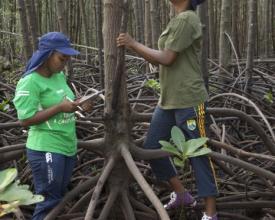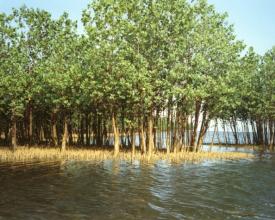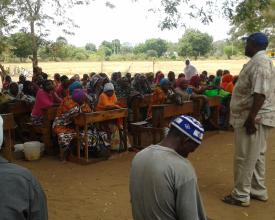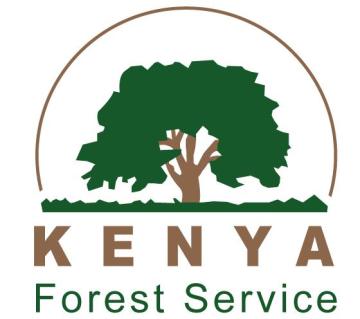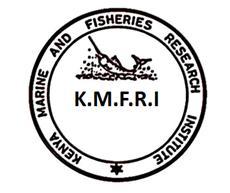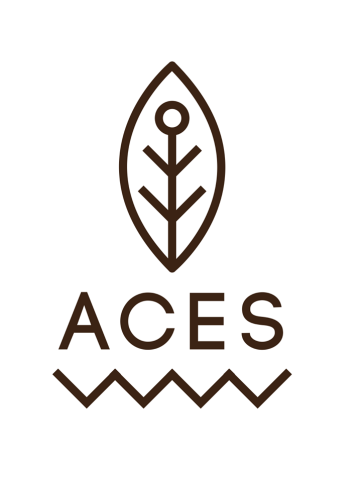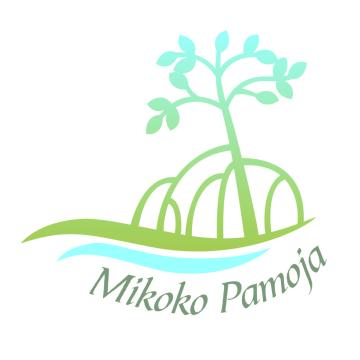
Los créditos de carbono azul financian la gestión comunitaria de los manglares

Se trata del primer proyecto comunitario de este tipo en el mundo: Mikoko Pamoja promueve la restauración y protección de los manglares en beneficio de la comunidad local. Está validado por Plan Vivo para generar y vender créditos de carbono de manglares a empresas y particulares que quieran mejorar sus credenciales ecológicas. Los ingresos generados por el comercio de créditos de carbono van a parar a un fondo de beneficio comunitario, gestionado por el grupo directivo Mikoko Pamoja, dirigido por la comunidad. El fondo apoya proyectos de desarrollo local en educación, agua y saneamiento, y reforestación de manglares.
Contexto
Défis à relever
- Explotación de los manglares por su madera y otros productos
- La pérdida de manglares tiene efectos negativos sobre la pesca, la sostenibilidad de los recursos y la integridad de los ecosistemas.
- La degradación de los manglares aumenta las emisiones de gases de efecto invernadero.
Ubicación
Procesar
Resumen del proceso
Debido a las elevadas emisiones del sector forestal, la CMNUCC desarrolló sistemas de incentivos a la conservación del carbono para permitir compensaciones económicas por una buena gestión de los bosques. Para que las comunidades de Kenia puedan obtener fondos a través de proyectos de carbono, es necesario que exista la legislación necesaria. La Ley Forestal (2005) permitió la formación de la Asociación Forestal Comunitaria (CFA) en Gazi Bay, a la que siguió la firma de un acuerdo de gestión forestal entre el Servicio Forestal de Kenia (KFS) y la comunidad. El acuerdo de gestión estipula las actividades comunitarias asignables en los bosques y permitió a la Organización Comunitaria Mikoko Pamoja (MPCO) dedicarse a la venta de créditos de carbono. El acuerdo proporcionó a MPCO la propiedad de una zona designada de manglares de la bahía de Gazi (aprox. 117 ha) en la que se llevan a cabo diversas actividades del proyecto, incluidos programas de educación y concienciación de la comunidad. La colaboración con el Instituto de Investigación Marina y Pesquera de Kenia (KMFRI) proporcionó los conocimientos técnicos necesarios para las evaluaciones del carbono y el desarrollo de niveles de emisión de referencia.
Bloques de construcción
Plan de gestión forestal participativa
Para que una comunidad participe en la gestión de bosques estatales (como los manglares), necesita firmar un acuerdo de gestión forestal (FMA) con el organismo gubernamental encargado del sector, en este caso el Servicio Forestal de Kenia (KFS). La firma del FMA va precedida de la formación de una Asociación Forestal Comunitaria (CFA) y la elaboración de un Plan de Gestión Forestal Participativa (PFMP) para la zona. Como su nombre indica, la elaboración del plan es un proceso participativo en el que se recogen y analizan las opiniones y preocupaciones de las distintas partes interesadas. El Plan de Gestión final incluye un mapa de zonificación que muestra las actividades de las distintas partes interesadas en la zona forestal designada. El Plan de Gestión Forestal Participativa entra en funcionamiento una vez que el Director del Servicio Forestal de Kenia, el organismo estatal encargado de la gestión forestal en Kenia, lo ha aprobado. El Plan para Mikoko Pamoja se aprobó en mayo de 2013, seguido de la firma del acuerdo de gestión forestal en octubre de 2013.
Factores facilitadores
- Mayor educación y concienciación de la comunidad sobre los valores de los bienes y servicios de los manglares.
- Aumento de las amenazas a los recursos de los manglares por la deforestación y la degradación forestal.
- Voluntad de la comunidad de cogestionar los manglares con el gobierno.
- Creación de una asociación forestal comunitaria en Gazi.
- Fuerte apoyo del gobierno, el sector privado, las ONG y las organizaciones de investigación.
- Un plan de zonificación claro para cada uno de los grupos de usuarios dentro de la CFA.
Lección aprendida
- La elaboración de un plan de gestión forestal participativa debe ser una actividad transparente y que incluya a todas las partes.
- El proceso lleva mucho tiempo, sobre todo cuando hay que tener en cuenta opiniones divergentes.
- La planificación es un proceso dinámico, por lo que es más fácil llegar a un consenso lo antes posible y dejar margen para futuros cambios.
- La aceptación por parte de la comunidad del proceso de planificación de la gestión es fundamental para su plena aplicación.
- Es necesario asignar recursos al desarrollo del plan de gestión forestal, ya que puede ser un proceso bastante costoso. El coste del desarrollo de un PFMP para Gazi Bay se estimó en 30.000 dólares, gran parte de los cuales se destinaron a las negociaciones con la comunidad y al desarrollo de capacidades.
Acuerdo de gestión forestal
El Acuerdo de Gestión Forestal es un instrumento jurídico entre la Asociación Forestal Comunitaria (CFA) y el Servicio Forestal de Kenia (KFS) para la aplicación del Plan de Gestión Forestal Participativa, que sólo entra en vigor tras la firma del Acuerdo. Este acuerdo garantiza oficialmente la propiedad comunitaria de los créditos de carbono y, por tanto, es un requisito previo para el éxito de un proyecto de carbono.
En resumen, el Acuerdo de Gestión Forestal es el vehículo para hacer operativo el Plan de Gestión Forestal Participativa.
Factores facilitadores
- El proceso está anclado en las leyes nacionales, Ley Forestal (2005)
- Comprensión por parte de la comunidad de los valores de los bienes y servicios de los manglares
- Voluntad de la comunidad de participar en la gestión conjunta de los manglares con el gobierno
- Registro de una asociación forestal comunitaria (AFC)
- Plan de gestión forestal participativa aprobado para el ecosistema forestal
Lección aprendida
- Es necesario llegar a un consenso antes de firmar un acuerdo de gestión forestal entre el gobierno y la comunidad local.
- El acuerdo afirma la propiedad comunitaria de una zona forestal designada, aumentando así su participación.
- La gestión de los manglares debe llevarse a cabo de forma integrada, en lugar de hacer demasiado hincapié en los beneficios del carbono a expensas de otros bienes y servicios derivados del sistema.
- El acuerdo de gestión forestal debe estar redactado en un lenguaje sencillo y comprensible para la comunidad.
Conocimientos sobre el carbono gracias a una sólida asociación
Las iniciativas de compensación de carbono requieren una sólida base científica para determinar las reservas de carbono y las líneas de base. Mikoko Pamoja se beneficia de una sólida asociación con el Instituto de Investigación Marina y Pesquera de Kenia (KMFRI), que llevó a cabo una investigación para proporcionar los datos de referencia necesarios para el proyecto de compensación de carbono.
KMFRI proporciona ahora apoyo técnico durante la ejecución de Mikoko Pamoja. Un miembro del KMFRI forma parte del comité directivo de Mikoko Pamoja para informar sobre los resultados del seguimiento. Posteriormente, se presenta un informe anual a la organización Plan Vivo en el que se detallan las actividades del proyecto. La posición de KMFRI es fundamental para determinar la exactitud de la información presentada a Plan Vivo.
Factores facilitadores
- La fuerte presencia del KMFRI en el lugar del proyecto, la bahía de Gazi: El Instituto lleva trabajando en la investigación de los manglares desde los años 80 y tiene una estación de campo en el pueblo de Gazi
- Sólidos conocimientos técnicos y participación a largo plazo en redes nacionales e internacionales (Earthwatch Institute, International Blue Carbon Scientific Working Group)
- Personal permanente residente y estudiantes en la estación KMFRI de Gazi
- Fuerte asociación con la comunidad local durante el desarrollo y la ejecución de las actividades en los manglares
Lección aprendida
- Las iniciativas de compensación de carbono requieren una sólida base científica para determinar las reservas de carbono y las líneas de base
- Se requiere una buena relación entre científicos, organismos gubernamentales y comunidades para la sostenibilidad de los proyectos
- Se requiere transparencia en todas las fases del desarrollo de los proyectos de carbono. Esto garantiza que no haya sobreexpectativas entre la comunidad incluso cuando los precios del carbono fluctúen
- El reparto de beneficios debe determinarse previamente durante la fase de desarrollo del proyecto. Esto garantiza la armonía entre los socios del proyecto.
- La sólida asociación entre KMFRI y la comunidad de Gazi ha permitido obtener rápidamente beneficios del carbono
- Mikoko Pamoja cuenta con socios locales e internacionales, como el Earthwatch Institute (Reino Unido) y la Universidad Napier de Edimburgo (Escocia), que han desempeñado un papel fundamental a la hora de poner en contacto a la comunidad con los compradores de carbono.
Educación y sensibilización medioambiental de la comunidad
Para promover la concienciación y la comprensión general de la importancia local y global del ecosistema de manglares para la comunidad de Gazi Bay, se celebraron varios foros de participación de las partes interesadas durante el inicio, el desarrollo y la ejecución del proyecto. Se organizaron reuniones en las aldeas, en las que el equipo de Mikoko Pamoja hizo presentaciones detalladas sobre los valores del ecosistema de manglares, las amenazas y las posibles medidas de mitigación. El equipo también introdujo el concepto de financiación del carbono, sus beneficios para las personas y el medio ambiente, y buscó el apoyo de la comunidad. Además, el equipo organizó una serie de debates de grupo para conocer mejor las percepciones y actitudes de la comunidad respecto a la conservación y gestión de los recursos de los manglares. Estas reuniones han generado confianza entre la comunidad, el gobierno y el equipo de Mikoko Pamoja. Esto se ve reforzado por las ventas anuales de créditos de carbono capturados por los manglares.
Factores facilitadores
- Presencia de un liderazgo estructurado en las aldeas participantes por el que el presidente de la aldea tiene su propio equipo que prevé la gobernanza de los asuntos comunitarios
- Transparencia en la prestación de servicios: todas las actividades del grupo se publican en tablones de anuncios comunitarios situados estratégicamente en las aldeas
- Beneficios demostrables del proyecto de carbono
- Apoyo a proyectos comunitarios con ingresos procedentes de la venta de créditos de carbono, como agua y saneamiento, educación y conservación del medio ambiente
Lección aprendida
- Algunos miembros de la comunidad tienen dificultades para comprender el concepto y los aspectos técnicos del comercio de emisiones.
- Siempre es difícil llegar a un consenso sobre el reparto de beneficios
- Los precios fluctuantes de los créditos de carbono mundiales están afectando negativamente a la moral de la comunidad para gestionar de forma sostenible los recursos de los manglares en sus zonas.
- Existe una necesidad urgente de mejorar la educación y la concienciación de la comunidad más allá del carbono de los manglares y, en su lugar, de todos los servicios ecosistémicos de los manglares, como la pesca y las funciones de protección de la costa.
- Hay una gran necesidad de desarrollar estrategias para la rehabilitación de las zonas de manglares degradadas fuera de los sitios de Mikoko Pamoja.
Impactos
A través de Mikoko Pamoja, la comunidad dispone de un poderoso mecanismo para generar ingresos, de los que se benefician proyectos comunitarios de salud, educación y gestión de manglares. Los esfuerzos de restauración de las zonas de manglares perdidas aumentan la cantidad de carbono que puede almacenarse y, junto con la mayor restauración y protección de los manglares, se espera una reducción total de emisiones de 50.000 toneladas de CO2 en los próximos 20 años. Además, los manglares sanos son zonas de cría para los peces, garantizan la protección de la costa y contribuyen a la estabilización de los sedimentos. Dado que la comunidad local se siente muy identificada con el proyecto, también se han mejorado los niveles de educación y la concienciación sobre la importancia de unos manglares sanos. El éxito de Mikoko Pamoja se está reproduciendo en la costa sur de Kenia, en Vanga, y en Madagascar, Tanzania y Mozambique, países del Océano Índico occidental.
Beneficiarios
- La comunidad local de Gazi Bay
- La Organización Comunitaria Mikoko Pamoja (MPCO)
- El Servicio Forestal de Kenia (KFS)
Objetivos de Desarrollo Sostenible
Historia
En Mikoko Pamoja, la comunidad vive en armonía con el entorno natural de los manglares. Es el primer bosque comunitario que comercia y se beneficia de la venta de créditos de carbono de los manglares. Algunas de las personas más pobres del planeta dependen de los manglares que bordean la costa de Kenia. Como puente entre el mar y la tierra, los manglares ofrecen protección contra las tormentas, zonas de alimentación y criaderos de peces, así como productos madereros cosechables, como la leña. Y los manglares ofrecen otro servicio al planeta: incluso más que los bosques terrestres, combaten el cambio climático absorbiendo carbono del aire y almacenándolo de forma segura bajo tierra. La capacidad de los manglares para capturar y almacenar carbono se ha estimado entre 3 y 5 veces superior a la de cualquier bosque terrestre productivo. Sin embargo, entre el 30% y el 50% de todos los manglares del mundo han sido talados o quemados en el último medio siglo, lo que los sitúa entre los ecosistemas más amenazados de la Tierra. Teniendo en cuenta el valor de estos bosques costeros, su continua destrucción es uno de los grandes fracasos del mercado mundial. Centrados en la bahía de Gazi, en el sur de Kenia, los investigadores han explorado nuevas formas de demostrar el valor de los manglares y aprovechar su potencial de almacenamiento de carbono en beneficio de las comunidades costeras pobres. Trabajos anteriores en la bahía de Gazi, dirigidos por James Kairo, del Instituto de Investigación Marina y Pesquera de Kenia, y Mark Huxham, de la Universidad Napier de Edimburgo, demostraron cómo restaurar los manglares talados, incluso en zonas donde los tocones salados llevaban 40 años sin vida. Ahora, el equipo colabora con un programa internacional de "créditos de carbono" para vender el carbono almacenado gracias a la reforestación y conservación de los manglares. Los pequeños proyectos comunitarios -en Kenia y en todo el mundo- podrían encajar en el programa de la ONU para reducir las emisiones derivadas de la deforestación y la degradación de los bosques (REDD). Investigadores y gestores forestales keniatas están estudiando medidas para convertir los manglares vulnerables en lugares REDD rentables. Aprovechando las lecciones de Gazi Bay, muchas más comunidades podrían obtener un valor cada vez mayor de unos bosques costeros sanos. El éxito de Mikoko Pamoja se está reproduciendo en otras partes de la costa keniana y en la región del Océano Índico Occidental.
